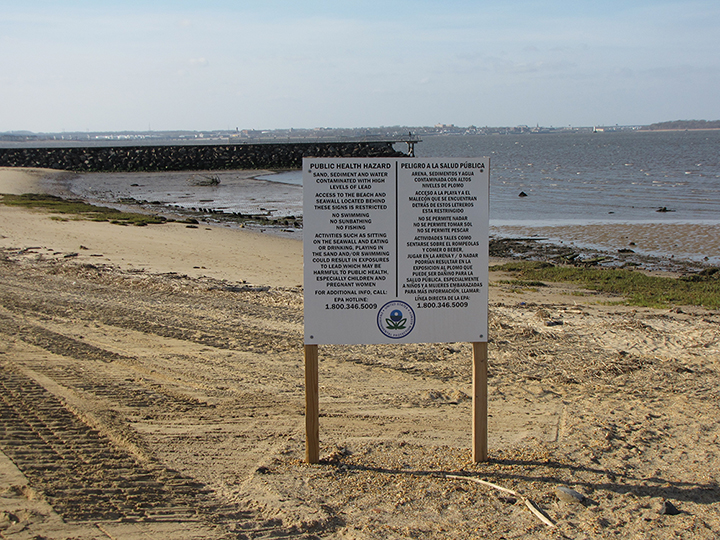Working to Reverse the Legacy of Lead in New Jersey's Raritan Bay
JANUARY 13, 2016 -- Once lined with reeds, oysters, and resort towns, New Jersey's Raritan Bay, like many other bodies of water, today is feeling the effects of industrial transformation begun decades ago. Around 1925, the National Lead Company became the largest lead company in the United States. The company is perhaps best known for their white-lead paints, sold under the Dutch Boy label. One of its many facilities was located in Perth Amboy, a town on the western edge of Raritan Bay, where it operated a lead smelter that generated wastes containing lead and other hazardous substances.
A Toxic Toll
During the late 1960s and early 1970s, slag from National Lead's lead smelter in Perth Amboy was used as building material to construct a seawall along the southern shoreline of Raritan Bay, several miles to the south of the facility. Slag is a stony waste by-product of smelting or refining processes containing various metals. Slag, battery casings, and demolition debris were used to fill in some areas of a nearby marsh and littered the marsh and beaches along the bay. In September 1972, the New Jersey Department of Environmental Protection received a tip that the slag being placed along Raritan Bay at the Laurence Harbor beachfront contained lead. Over time, contamination from the slag and other wastes began leaching into the water, soil, and sediments of Raritan Bay, which is home to a variety of aquatic life, including flounder, clams, and horseshoe crabs, but evidence of the pollution only became available decades later.
Cleaner Futures
By 2007 the New Jersey Department of Environmental Protection had confirmed high levels of lead and other metals in soils of Old Bridge Waterfront Park on Raritan Bay's south shore. State and local officials put up temporary fencing and warning signs and notified the public about health concerns stemming from the lead in the seawall. The following year, New Jersey asked the U.S. Environmental Protection Agency (EPA) to consider cleaning up contaminated areas along the seawall because of the elevated levels of metals. By November 2009, the EPA confirmed the contamination and declared this polluted area in and near Old Bridge Waterfront Park a Superfund site (called Raritan Bay Slag Superfund site). They installed signs and fencing at a creek, marsh, and some beaches to restrict access and protect public health. In May 2013 EPA selected a cleanup strategy, known as a "remedy," to address risks to the public and environment from the pollution, and in January 2014 they ordered NL Industries, which in 1971 had changed its name from the National Lead Company, to conduct a $79 million cleanup along Raritan Bay. Cleanup will involve digging up and dredging the slag, battery casings, associated waste, and sediment and soils where lead exceeds 400 parts per million. An EPA news release from January 2014 emphasizes the concern over lead: "Lead is a toxic metal that is especially dangerous to children because their growing bodies can absorb more of it than adults. Lead in children can result in I.Q. deficiencies, reading and learning disabilities, reduced attention spans, hyperactivity and other behavioral disorders. The order requires the removal of lead-contaminated material and its replacement with clean material in order to reduce the risk to those who use the beach, particularly children."
Identifying Impacts

After the Raritan Bay Slag site became a Superfund site in late 2009, NOAA's Office of Response and Restoration worked with the EPA to determine the nature, extent, and effects of the contamination. Under a Natural Resource Damage Assessment, NOAA's Damage Assessment, Remediation, and Restoration Program and our co-trustees, the U.S. Fish and Wildlife Service and the New Jersey Department of Environmental Protection, have been assessing and quantifying the likely impacts to the natural resources and the public’s use of those resources that may have occurred due to the contamination along Raritan Bay. As part of this work, we are identifying opportunities for restoration projects that will compensate for the environmental harm as well as for people’s inability to use the affected natural resources, for example, due to beach closures and restricted access to fishing. "The south shore of Raritan Bay is an important ecological, recreational, and economic resource for the New York-New Jersey Harbor metropolitan area," said NOAA Regional Resource Coordinator Lisa Rosman. "Cleanup and restoration are key to improving conditions and allowing public access to this valuable resource." Watch for future updates on progress toward restoration on Raritan Bay.
 An official website of the United States government.
An official website of the United States government. 

